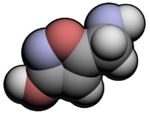Muscimol
 |
|
 |
|
| Names | |
|---|---|
|
IUPAC name
5-(Aminomethyl)-isoxazol-3-ol
|
|
| Identifiers | |
|
2763-96-4 |
|
| 3D model (Jmol) | Interactive image |
| ChEBI |
CHEBI:7035 |
| ChEMBL |
ChEMBL273481 |
| ChemSpider |
4116 |
| ECHA InfoCard | 100.018.574 |
| 4259 | |
| PubChem | 4266 |
|
|
|
|
| Properties | |
| C4H6N2O2 | |
| Molar mass | 114.10 g·mol−1 |
| Melting point | 184 to 185 °C (363 to 365 °F; 457 to 458 K) |
| very soluble | |
| Solubility in ethanol | slightly soluble |
| Solubility in methanol | very soluble |
| Pharmacology | |
| Legal status |
|
|
Except where otherwise noted, data are given for materials in their standard state (at 25 °C [77 °F], 100 kPa).
|
|
|
|
|
| Infobox references | |
Muscimol (also known as agarin or pantherine) is the principal psychoactive constituent of Amanita muscaria and related species of mushroom. Muscimol acts as a potent, selective agonist for the GABAA receptors and displays sedative-hypnotic and dissociative psychoactivity.
Muscimol is the psychoactive compound responsible for the effects of Amanita muscaria intoxication. Ibotenic acid, a neurotoxic secondary metabolite of Amanita muscaria, serves as a prodrug to muscimol when the mushroom is ingested or dried, converting to muscimol via decarboxylation.
It can be produced synthetically from propargyl chloride. The lithium acetylide is produced by reaction with BuLi. Remaining at -40 °C this is treated with a two-fold excess of ethyl chloroformate to afford ethyl 4-chlorotetrolate. This is added to an aqueous methanolic solution of basic hydroxylamine at -35 °C followed 15 min later by a pH 7 aqueous buffer so as to give a final pH between 8.5 and 9 for optimum cyclisation. The resulting chloromethylisoxazole is heated to 50 °C in a solution of methanol saturated (at 0 °C) with anhydrous ammonia for 5 hours in a sealed flask to give muscimol. The overall yield achieved in the literature was 18.7%.
Muscimol is produced naturally in the mushrooms Amanita muscaria and Amanita pantherina, along with muscarine, muscazone, and ibotenic acid.A. muscaria and A. pantherina should be eaten with caution and prepared properly to lessen effects of nausea; no official deaths from poisoning have been recorded from A. muscaria and A. pantherina. In A. muscaria, the layer just below the skin of the cap contains the highest amount of muscimol, and is therefore the most psychoactive portion.
...
Wikipedia
